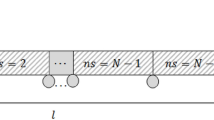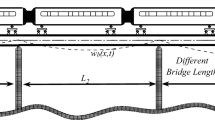Abstract
This paper addresses the dynamic response of a continuous beam bridge with different levels of track irregularities under a single, moving high-speed train. The train is modeled as one-foot sprung masses. The bridge is described as an Euler-Bernoulli beam supported by several hinged supports. Rayleigh damping coefficients of the bridge are calculated by using the modal damping ratio. Random track irregularities are generated by power spectrum density functions. The interaction equation of motion is derived and then solved by using the Newmark-beta method combined with the Newton-Raphson method. The dynamic impact factors of a single-span simply supported bridge and a five-span continuous beam bridge under the same train are calculated and compared for verification. Additionally, a three-span continuous beam bridge with various damping ratios and track irregularities under a Korea Train Express (KTX) train is used as an example to investigate the dynamic impact factors at the midpoints of different bridge spans in both downward and upward directions, the deck rotations at the bridge supports, and the average maximum acceleration of the train bodies under different conditions.
Similar content being viewed by others
References
Akin, J. and Mofid, M. (1989). “Numerical solution for response of beams with moving mass.” Journal of Structural Engineering, 115(1), pp. 120–131.
Au, F.-T.-K., Wang, J.-J., and Cheung, Y.-K. (2002). “Impact study of cable-stayed railway bridges with random rail irregularities.” Engineering Structures, 24(5), pp. 529–541.
Cheng, Y.-S., Au, F.-T.-K., and Cheung, Y.-K. (2001). “Vibration of railway bridges under a moving train by using bridge-track-vehicle element.” Engineering Structures, 23(12), pp. 1597–1606.
Cheung, Y.-K., Au, F.-T.-K., Zheng, D.-Y., and Cheng, Y.-S. (1999). “Vibration of multi-span non-uniform bridges under moving vehicles and trains by using modified beam vibration functions.” Journal of Sound and Vibration, 228(3), pp. 611–628.
Chu, K., Garg, V., and Wang, T. (1986). “Impact in railway prestressed concrete bridges.” Journal of Structural Engineering, 112(5), pp. 1036–1051.
Dehestani, M., Mofid, M., and Vafai, A. (2009). “Investigation of critical influential speed for moving mass problems on beams.” Applied Mathematical Modelling, 33(10), pp. 3885–3895.
Fryba, L. (2001). “A rough assessment of railway bridges for high speed trains.” Engineering Structures, 23(5), pp. 548–556.
Hamid, A. and Yang, T.-L. (1982). Analytical descriptions of track-geometry variations. Transportation Research Board, pp. 19–26.
Johansson, C., Pacoste, C., and Karoumi, R. (2013). “Closed-form solution for the mode superposition analysis of the vibration in multi-span beam bridges caused by concentrated moving loads.” Computers & Structures, 119, pp. 85–94.
Kwark, J.-W., Choi, E.-S., Kim, Y.-J., Kim, B.-S., and Kim, S.-I. (2004). “Dynamic behavior of two-span continuous concrete bridges under moving high-speed train.” Computers & Structures, 82(4–5), pp. 463–474.
Lacarbonara, W. and Colone, V. (2007). “Dynamic response of arch bridges traversed by high-speed trains.” Journal of Sound and Vibration, 304(1–2), pp. 72–90.
Lu, Y., Mao, L., and Woodward, P. (2012). “Frequency characteristics of railway bridge response to moving trains with consideration of train mass.” Engineering Structures, 42, pp. 9–22.
Majka, M. and Hartnett, M. (2008). “Effects of speed, load and damping on the dynamic response of railway bridges and vehicles.” Computers & Structures, 86(6), pp. 556–572.
Mao, L. and Lu, Y. (2013). “Critical speed and resonance criteria of railway bridge response to moving trains.” Journal of Bridge Engineering, 18(2), pp. 131–141.
Mazilu, T. (2013). “Instability of a train of oscillators moving along a beam on a viscoelastic foundation.” Journal of Sound and Vibration, 332(19), pp. 4597–4619.
Nikkhoo, A., Rofooei, F. R., and Shadnam, M. R. (2007). “Dynamic behavior and modal control of beams under moving mass.” Journal of Sound and Vibration, 306(3–5), pp. 712–724.
Olsson, M. (1985). “Finite element, modal co-ordinate analysis of structures subjected to moving loads.” Journal of Sound and Vibration, 99(1), pp. 1–12.
Shin, J.-R., An, Y.-K., Sohn, H., and Yun, C.-B. (2010). “Vibration reduction of high-speed railway bridges by adding size-adjusted vehicles.” Engineering Structures, 32(9), pp. 2839–2849.
Stancioiu, D., Ouyang, H., Mottershead, J. E., and James, S. (2011). “Experimental investigations of a multi-span flexible structure subjected to moving masses.” Journal of Sound and Vibration, 330(9), pp. 2004–2016.
Thambiratnam, D. and Zhuge, Y. (1996). “Dynamic analysis of beams on an elastic foundation subjected to moving loads.” Journal of Sound and Vibration, 198(2), pp. 149–169.
Wang, Y.-M. (1998). “The dynamical analysis of a finite inextensible beam with an attached accelerating mass.” International Journal of Solids and Structures, 35(9–10), pp. 831–854.
Wu, Y.-S. and Yang, Y.-B. (2003). “Steady-state response and riding comfort of trains moving over a series of simply supported bridges.” Engineering Structures, 25(2), pp. 251–265.
Yang, Y.-B. and Lin, B.-H. (1995). “Vehicle-bridge interaction analysis by dynamic condensation method.” Journal of Structural Engineering, 121(11), pp. 1636–1643.
Yang, Y.-B. and Yau, J.-D. (1997). “Vehicle-bridge interaction element for dynamic analysis.” Journal of Structural Engineering, 123(11), pp. 1512–1518.
Yang, Y.-B., Yau, J.-D., and Hsu, L.-C. (1997). “Vibration of simple beams due to trains moving at high speeds.” Engineering Structures, 19(11), pp. 936–944.
Author information
Authors and Affiliations
Corresponding author
Additional information
Discussion open until May 1, 2015. This manuscript for this paper was submitted for review and possible publication on March 10, 2014; approved on December 1, 2014.
Rights and permissions
About this article
Cite this article
Mu, D., Choi, DH. Dynamic responses of a continuous beam railway bridge under moving high speed train with random track irregularity. Int J Steel Struct 14, 797–810 (2014). https://doi.org/10.1007/s13296-014-1211-1
Published:
Issue Date:
DOI: https://doi.org/10.1007/s13296-014-1211-1




